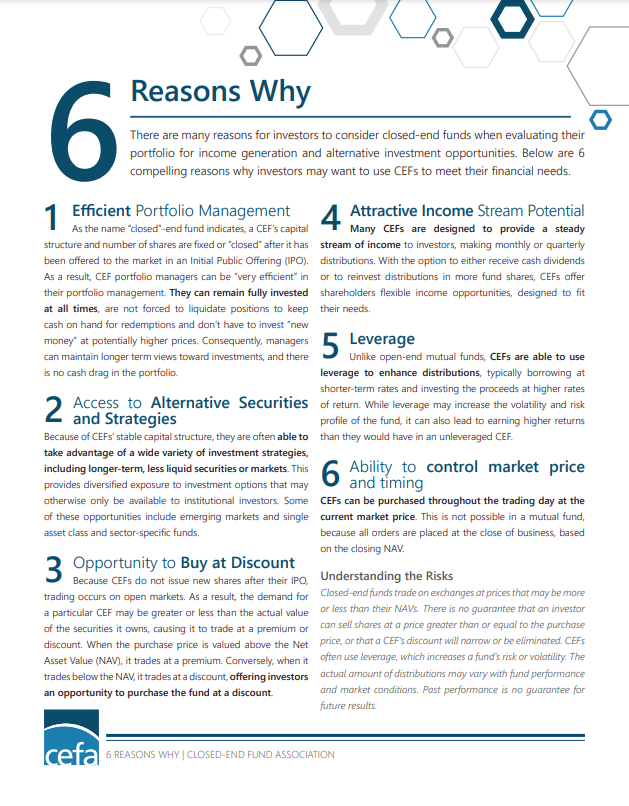There are many reasons for investors to consider closed-end funds when evaluating their portfolio for income generation and alternative investment opportunities. Below are 6 compelling reasons why investors may want to use CEFs to meet their financial needs.
1. Efficient Portfolio Management
As the name “closed”-end fund indicates, a CEF’s capital structure and number of shares are fixed or “closed” after it has been offered to the market in an Initial Public Offering (IPO). As a result, CEF portfolio managers can be “very efficient” in their portfolio management. They can remain fully invested at all times, are not forced to liquidate positions to keep cash on hand for redemptions and don’t have to invest “new money” at potentially higher prices. Consequently, managers can maintain longer term views toward investments, and there is no cash drag in the portfolio.
2. Access to Alternative Securities and Strategies
Because of CEFs’ stable capital structure, they are often able to take advantage of a wide variety of investment strategies, including longer-term, less liquid securities or markets. This provides diversified exposure to investment options that may otherwise only be available to institutional investors. Some of these opportunities include emerging markets and single asset class and sector-specific funds.
3. Opportunity to Buy at Discount
Because CEFs do not issue new shares after their IPO, trading occurs on open markets. As a result, the demand for a particular CEF may be greater or less than the actual value of the securities it owns, causing it to trade at a premium or discount. When the purchase price is valued above the Net Asset Value (NAV), it trades at a premium. Conversely, when it trades below the NAV, it trades at a discount, offering investors an opportunity to purchase the fund at a discount.
4. Attractive Income Stream Potential
Many CEFs are designed to provide a steady stream of income to investors, making monthly or quarterly distributions. With the option to either receive cash dividends or to reinvest distributions in more fund shares, CEFs offer shareholders flexible income opportunities, designed to fit their needs.
5. Leverage
Unlike open-end mutual funds, CEFs are able to use leverage to enhance distributions, typically borrowing at shorter-term rates and investing the proceeds at higher rates of return. While leverage may increase the volatility and risk profile of the fund, it can also lead to earning higher returns than they would have in an unleveraged CEF.
6. Ability to control market price and timing
CEFs can be purchased throughout the trading day at the current market price. This is not possible in a mutual fund, because all orders are placed at the close of business, based on the closing NAV.
Understanding the Risks
Closed-end funds trade on exchanges at prices that may be more or less than their NAVs. There is no guarantee that an investor can sell shares at a price greater than or equal to the purchase price, or that a CEF’s discount will narrow or be eliminated. CEFs often use leverage, which increases a fund’s risk or volatility. The actual amount of distributions may vary with fund performance and market conditions. Past performance is no guarantee for future results.
Download the PDF:
